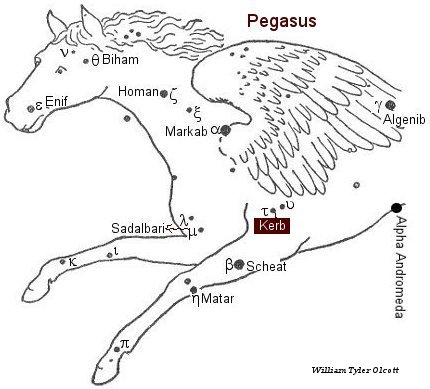| Fixed star: KERB | |
| Constellation: Tau (τ) Pegasus | |
| Longitude 1900: 29PIS40 | Longitude 2000: 01ARI03 |
| Declination 1900: +23.12′ | Declination 1900: +23.43′ |
| Right ascension: 23h 20m | Latitude: +25.34′ |
| Spectral class: A5 | Magnitude: 4.6 |
The history of the star: Kerb
from p.329 of Star Names, Richard Hinckley Allen, 1889.
[A scanned copy can be viewed on this webpage
Tau (τ) Pegasus, Kerb, is a star in the Flying Horse.
Tau (τ, Kerb), with upsilon (υ), was the 10th century Persian astronomical writer Al Sufi’s Sa’d al Naamah, which Knobel thinks should be Al Na’aim, the Cross-bars over a well; but they also were known as Al Karab, the Bucket-rope.
The usual titles for tau (τ Kerb)—Markab and Sagma or Salma — are from the 17th century German astronomer Bayer, but the last two should be Salm, a Leathern Bucket.
Star Names, Their Lore and Meaning, Richard Hinckley Allen, 1889].
The astrological influences of the constellation Pegasus
Legend: Pegasus was born from the blood of Medusa (see Algol) after Perseus had cut off her head, and was afterwards tamed and ridden by Bellerophon. Being weary of earthly affairs Bellerophon attempted to fly to heaven but fell off, and Pegasus continued his course, entered heaven and took his place among the stars. [Robson, p.56.]
Influences: According to Ptolemy the bright stars are like Mars and Mercury. The constellation gives ambition, vanity, intuition, enthusiasm, caprice and bad judgment. [Robson, p.56.]
The constellation portends events concerning ships and the ocean and also changes in the weather. In medieval times it was said to indicate vain individuals with a great deal of ambition, but with very poor judgment. [Fixed Stars and Judicial Astrology, George Noonan, 1990, p.22.]
The Pegasus Syndrome, as exemplified in the legends of Perseus and Bellerophon, is concerned with the innate ability possessed by some people to negotiate difficulties by rising above them, on the one hand, and the danger of overreaching themselves, on the other. Pegasus, by birth, is the child of Medusa and Neptune, symbols of ‘wisdom’ and ’emotion,’ respectively, which shows the dichotomy of his nature. As in the story, Bellerophon attempted to fly to Olympus (overreach his potential). He believed that Pegasus was subject to his will. However, it was Pegasus who made it to Olympus, while Bellerophon was tossed back to earth, lame and reproached by others. It is unwise to take any situation for granted as the ‘lesser’ person (or, in this case, beast) may be the very one to teach us the much needed lesson in humility. Pegasus is also indicative of a specific mission in life which the inquirer will always find the time and energy to pursue, although the path may be sewn with difficulties (the Chimaera) and limitations (Bellerophon’s doubt or arrogance). So, the Pegasus Syndrome is the seeming ability to “fly over any situation,” though the reverse may be a lesson in humility, being “taken down a peg,” as it were. [Rich’s Pegopediahttp://thanasis.com/pegasus.htm].
The astrological influences of the constellation Pegasus given by Manilius:
Pegasus the winged Horse will appear and gallop aloft in the heavens. It will bring forth people endowed with swiftness of movement and limbs alert to perform every task. One man will cause his horse to wheel round in caracoles, and proudly mounted on its back he will wage war from on high; horseman and soldier in one. Another will possess the ability to rob the racecourse of its true length such is his speed that he will seem to dissemble the movement of his feet and make the ground vanish before him. Who more swiftly could fly back from the ends of the earth as messenger or with light foot to the earth’s ends make his way? He will also heal a horse’s wounds with the sap of common plants, and will know the herbs which bring aid to an animal’s limbs and those which grow for the use of man.” [Manilius, Astronomica, 1st century AD, book 5, p.350-353.]
The astrological influences of the star Kerb
Danger of being jilted by a lover. [Fixed Stars and Judicial Astrology, George Noonan, 1990, p.22.].
References:
Fixed Stars and Constellations in Astrology, Vivian E. Robson, 1923].
